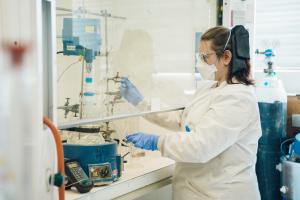Nuclear power stations could produce hydrogen, heat homes and decarbonise heavy industry with surplus heat and electricity
Royal Society Media Release
Nuclear power stations could produce hydrogen, heat homes and decarbonise heavy industry with surplus heat and electricity
A new generation of nuclear reactors could help the UK cut carbon emissions by harnessing surplus energy to heat homes, produce hydrogen, and decarbonise industry, according to a report by the Royal Society.
Prof. Bill Lee of Bangor University’s Nuclear Futures Institute is a co-author of Nuclear cogeneration: civil nuclear energy in a low-carbon future. The policy briefing sets out how planned and future nuclear projects can complement renewables and help the UK meet its net-zero carbon emissions pledge by 2050.
Cogeneration gives nuclear power the flexibility it needs to function in an energy system where a growing proportion of electricity comes from intermittent renewables. When domestic energy demand is being met by wind, solar, or other sources, cogeneration allows a nuclear plant to switch from electricity generation to cogeneration applications such as the production of hydrogen.
Small modular reactors (SMRs) are of particular interest. These are reactors producing 300Mw of energy or less, which can be built in factories and deployed in stages. This should mean lower investment costs and economies of scale in construction. It also gives greater flexibility in locating stations, and allows them to be tailored to the energy needs of regional or industrial clusters
The next generation of SMRs – known as Advanced Modular Reactors (AMRs) – are expected to generate temperatures in excess of 600°C which are required by some of the hardest to de-carbonise processes, such as chemical production. It could potentially be used in the steel making process to reduce the industry’s carbon footprint.
Prof. Bill Lee highlighted that:
"The report shows that Cogeneration in the nuclear sector is not new and the UK has much experience of using nuclear power and heat for other benefits such as aluminium smelting on Anglesey in Wales and medical isotope production at Calder Hall at Sellafield. We just need to rediscover and expand our capability in this field, nuclear can be more than just low carbon electricity production".
Professor Robin Grimes FREng FRS, the report’s lead author and a professor of materials physics at Imperial College London, said. “What cogeneration gives us is options, and frankly, we need options when facing an uncertain future.”
“It will have to be a staged process,” Professor Grimes added. “We’ve already begun the move to electrification – most clearly in cars. Then you can look at using some nuclear power to produce hydrogen with electrolysis, and for low-carbon district heating.
“The much more difficult decarbonisation, like the chemical industry, that’s where you need advanced modular reactors, because they provide very high temperature heat.
“We could demonstrate the feasibility of a high temperature AMR reactor by 2035, while SMRs could be on the grid by 2028. It would be a key component of meeting the UK’s 2050 target.”
Cogeneration in the UK
Previous nuclear projects have shown the benefits of locating industry alongside nuclear stations. The Wylfa Magnox station on Anglesey, until recently the intended site for a Hitachi-built nuclear station, provided cheap electricity for Anglesey Aluminium’s smelting operation until 2009.
While there are no current nuclear cogeneration projects in the UK, there are options for future use:
District heating
District heating has been identified by the UK government as a key area to reduce carbon emissions and heating costs. However, most UK homes are heated with natural gas, accounting for 18% of all UK carbon dioxide emissions in 2018. District heating currently provides just 2% of heat demand in the UK but several countries already use nuclear cogeneration for district heating in colder climates, and in China, SMRs are being built solely to provide district heating.
Analysis suggests there are potentially 50 conurbations in the UK where SMR-powered district heating could work. One study identified a network centred on Hartlepool as having potential. Public opinion and acceptance of nuclear reactors being sited close to population centres would need to be examined.
High temperature industrial processes
Across the EU around a quarter of industrial processes, depend on high-temperature heat (above 400C), which could be generated by AMRs.
Possible applications for this high temperature heat in the UK, include:
- Hydrogen production, for use in zero-carbon fuels and energy storage
- Sustainable synthetic fuel production, including:
- Ammonia, a vital chemical for fertiliser which also has applications as a low-carbon fuel for marine shipping and aviation
- Synthetic fuels using carbon dioxide captured from the air and reacted with hydrogen
- Direct air capture of carbon dioxide, an energy intensive and inefficient process to remove CO2 from the atmosphere for industrial uses. Some analyses predict 5% of the steam produced by a nuclear power plant could satisfy 80% of the energy needed.
Challenges of implementing nuclear cogeneration
Demonstrating the efficiency of new reactors alongside consultation with local communities will be key to the expansion of UK nuclear generation. The report notes SMR’s simplified systems and designed-in safety features, in combination with their smaller scale, already reduces the hazard and risk of evacuation in the event of an accident.
Other outstanding issues include the ownership of reactors, the future demand for hydrogen and other cogeneration products at a regional, national and international level, and the cost of carbon and dependable power.
If the construction cost reductions for SMRs can be realised and the regulation and licencing processes streamlined, then the report notes the additional revenue benefits of cogeneration could be material for SMRs and for the future of nuclear generation in the UK.



